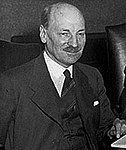14 November 1935 1945 → 23 May 1923 25 October 1935 473 seats, 55% 52 seats, 30.8% Start date November 14, 1935 Location United Kingdom | Turnout 71.1% (5.3%) 25 October 1935 5 October 1931 52 seats, 30.8% 35 seats, 3.7% End date 1935 | |
 | ||
Winner Stanley Baldwin | ||
United kingdom general election 1935
The United Kingdom general election held on Thursday, 14 November 1935 resulted in a large, albeit reduced, majority for the National Government now led by Conservative Stanley Baldwin. The greatest number of members, as before, were Conservatives, while the Liberal National vote held steady. The National Labour vote collapsed, and even the party leader Ramsay MacDonald lost his seat.
Contents
- United kingdom general election 1935
- Results
- Seats changing hands between parties
- Constituency Results
- References
Labour, under what was then regarded internally as the caretaker leadership of Clement Attlee following the resignation of George Lansbury slightly over a month before the election, made large gains over their very poor showing in the 1931 general election. The Liberals continued their slow political collapse and lost further ground, with their leader Sir Herbert Samuel losing his own seat.
The Independent Labour Party stood entirely separately from Labour for the first time since 1895, having stood candidates unendorsed by Labour at the 1931 general election and having disaffiliated fully from Labour in 1932. The Scottish National Party contested their first election, and the Communist Party gained their first parliamentary seat in almost ten years, West Fife.
The major election issues were the continuing unemployment problems and the role of the League of Nations, particularly as regarding the Empire of Japan.
No general elections were held during the Second World War until Allied victory was assured; hence the 1935 House sat until 1945. As a result, this parliament would see two leadership changes. Neville Chamberlain took over from Baldwin as Prime Minister and Leader of the Conservative Party in 1937. Chamberlain in turn resigned in 1940, when the office of Prime Minister passed to Winston Churchill, who linked the three main parties in the House of Commons in an all-party unity government for the duration of the Second World War.
Results
Total votes cast: 20,991,488. Turnout 71.1%. All parties shown. Conservatives include the Ulster and Scottish Unionists. Seats and votes won by the Independent Labour Party (ILP) are compared with seats and votes won by the official ILP candidates among the ILP candidates at the 1931 election who ran without national Labour Party endorsement.
Seats changing hands between parties
1sitting MP had defected to National Liberals
2sitting MP had defected to Liberals
Constituency Results
These are available on the Political Science Resources Elections Database, a link to which is given below.
